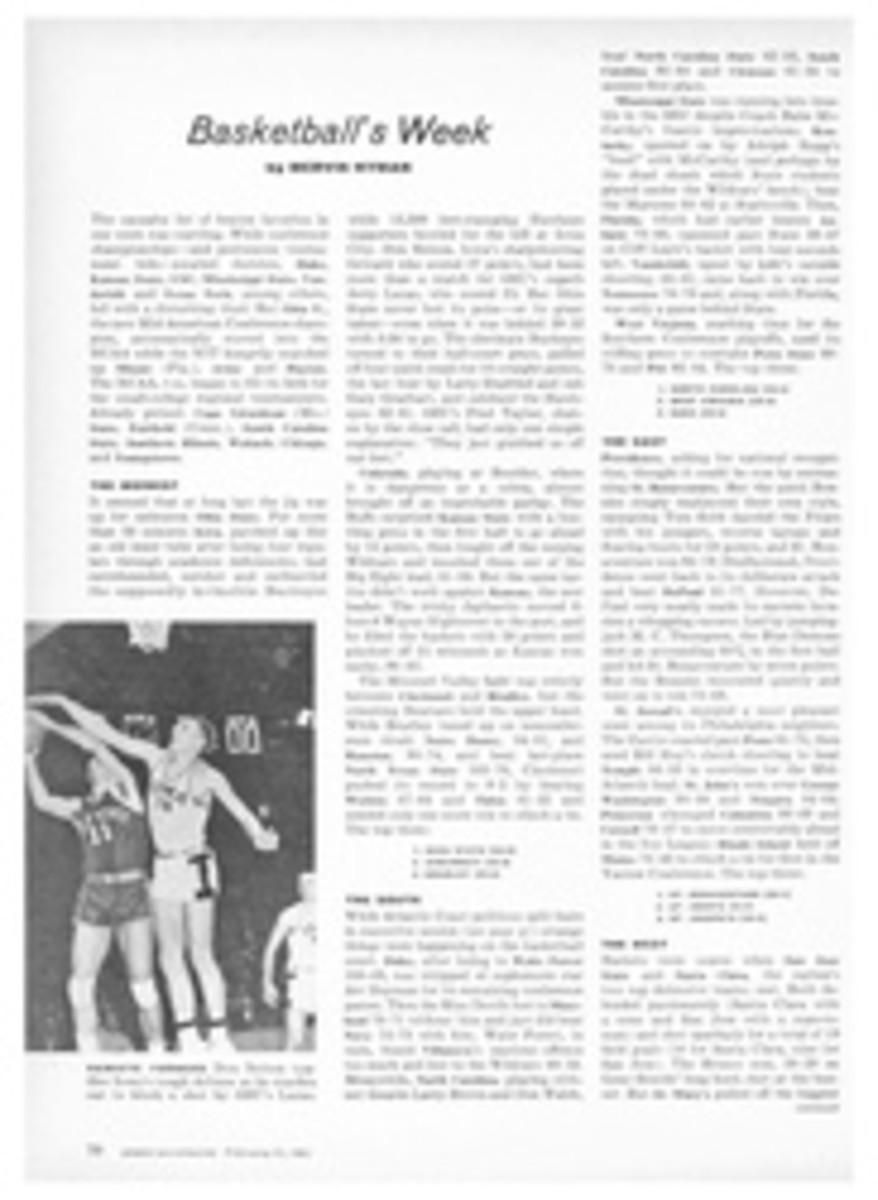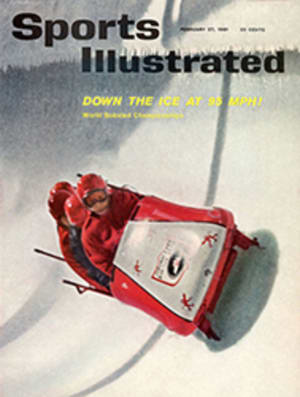
DUKE'S RED-HOT AND BLUE DEVIL
Duke and North Carolina, two testy and contentious southern neighbors whose basketball teams rank among the top seven in the country, are separated by only eight miles of gently rolling tobacco land. From the bitterness of the battle now raging between their partisans, eight light-years would be a more appropriate distance.
Triggered by an intense, strong and strikingly able young basketball player nicknamed The Pest, the trouble has already included a riot during a game, the suspension of three players, the impugning of the integrity of a conference commissioner, an Alice in Wonderland court trial and an uneaten birthday cake.
The Pest is Arthur Heyman. Off the basketball court he is an intelligent, peaceable 19-year-old Duke sophomore from Rockville Centre on Long Island. He has been brought up to say "sir" to his elders, and he wants to be a basketball player, not a cause cél√®bre.
On the court he is the 6-foot-5-inch, 205-pound offensive leader of the Duke Blue Devils, averaging 24.4 points a game. He is also the team's defensive leader, with 11 rebounds a game. His best play is a power-packed rush for the basket which carries him at, on and over anyone who is foolish enough to get in his way. It is a style calculated to make points, not friends. He plays the game as he learned it on the concrete schoolyards of Long Island, fiercely and joyously, combining the fervor of a Christian wrestling a lion with the confidence of a lion wrestling a Christian. He is very likely the finest sophomore of the year.
In the spring of 1959 Heyman sifted through 75 offers, decided to follow the underground railroad (SI, Feb. 4, 1957) which North Carolina Coach Frank McGuire had used for seven years to siphon talent from his native New York to the land of the drawl and the longleaf pine. Such Yankee imports had won one national championship and kept North Carolina consistently in the top 10, much to the dismay of the other three big basketball schools—Duke, Wake Forest and North Carolina State—which are clustered in the small area some coaches call Tobacco Road. McGuire, delighted at apparently getting Heyman, made a public announcement of his success.
Then, on May 6, 1959 Vic Bubas, a personable and persuasive 32-year-old, became head coach at Duke. The very next morning, May 7, he sat in the Playbill Restaurant of New York's Manhattan Hotel and convinced Art Heyman that he should not follow the rest of his New York friends to the University of North Carolina. Heyman's father, an engineer, agreed with Bubas, and Art went to Duke.
A man who knows baseball has called Heyman a "Billy Martin with talent," and any ballplayer who has ever itched to bust Martin one on the chin could have predicted what would happen. Heyman was soon scoring 30 points a game for the Duke freshmen, driving his team to victory and his opposition into a frenzy. In the game against the North Carolina freshmen he was at his exuberant best—until knocked cold by a roundhouse right to the jaw thrown by a furious and frustrated opponent. Five stitches were needed to repair Heyman.
This season Heyman was quite unawed at joining a Duke starting team made up exclusively of serious seniors. In the first 10 seconds of his first game he took a rebound and dribled the length of the floor, evading four LSU players and driving right over the fifth for a basket. He dubbed his teammates with unflattering nicknames—Howard Hurt, the quiet, restrained Duke captain, became Zipper Nose—but they gave him one, in turn, The Pest, and welcomed their forceful young newcomer.
"We worked hard to help Art control his temper and himself," says Vic Bubas, "and he has improved 100%."
Relations with North Carolina have not. Frank McGuire refused to use Heyman's name on his basketball television show. Bubas, in turn, claimed his three daughters refused to eat a birthday cake when the icing turned out to be light (Carolina) blue instead of dark (Duke) blue.
Crowds booed Heyman (and like Mantle, he can't understand why), but there was no serious incident until two weeks ago when North Carolina came to play at Duke before a raucous full house.
With nine seconds left, Duke had a five-point lead and Heyman had scored 36 points while being guarded by fellow New Yorker Doug Moe, conceded to be the top defensive player in the Atlantic Coast Conference. At this point Heyman fouled North Carolina's Larry Brown under the basket. Brown threw the ball into the crowd and a right and left to Heyman's face. Another Carolina player, Don Walsh, charged Heyman from behind, sending all three sprawling. "I was hit three times and had been spit at during the whole game before I started to fight," said Heyman later.
The 10 Durham policemen that Duke had hired specially for this game broke up the ensuing free-for-all involving players and fans.
"I didn't start it, I didn't start it. Please believe me," a crushed Heyman cried to Bubas on the bench. When films showed Heyman was right, Bubas told his player Duke would back him. "I would expect a son of mine to fight back after what Heyman took," said Bubas.
Attack and counterattack
The first postbrawl difficulty was almost ludicrous, but highly indicative of the tense situation. During half time of the game Heyman had brushed off a Carolina male cheerleader who had touched his shoulder. A Durham attorney and North Carolina alumnus saw the incident and swore out a warrant charging Heyman with assault and battery. When the cheerleader refused to testify, the attorney had him subpoenaed.
A local paper headlined, ART HEYMAN ACCUSED OF ASSAULTING CHEERLEADER. "It was awful," said Heyman, "like I'd attacked a girl." Last Monday, flanked by three Duke attorneys and before a courtroom packed by 300 spectators—"I felt like Al Capone"—Heyman saw his case quickly dismissed.
On Tuesday, while the team went to Winston-Salem for an important game against Wake Forest, Heyman and Bubas waited at Duke for Jim Weaver, the Atlantic Coast Conference Commissioner, to mete out punishment for the North Carolina riot. Weaver ruled that the two Carolina players had started the fight, but that Heyman counterattacked too zealously, and suspended all three from conference games this season.
Duke appealed, delaying the suspension, and then raced Heyman at 90 mph to Wake Forest where he arrived in time to score 31 points. But a hot Wake Forest team made a remarkable 61% of its shots and gave Duke its third loss in 20 games.
Suspension upheld
Next day the team went to Washington to play Maryland. Heyman and Bubas, however, flew to Charlotte for the appeal before the ACC executive committee. Weaver was upheld, meaning Heyman could not play in coming games against Maryland, Virginia or North Carolina.
On Thursday, while Frank McGuire was charging Weaver with "a personal vendetta against me," an attack so blunt it gave rise to rumors that McGuire was planning to leave North Carolina, Vic Bubas was trying to pull his Duke team together for a basketball game. "I've said you aren't a one-man team," he told them in the dressing room at Maryland. "Now prove it."
When Duke took the floor trying to protect its first-place position in the conference standings, Art Heyman was sitting in a radio booth high above the stands in the Maryland field house. He was caged and frantic. He took an announcer's cigarettes, shredded them into loose tobacco. He chewed up a plastic cup top. He tore up a statistics sheet.
"I didn't deserve this," he said, wondering how things had exploded out of all proportion around him. "How could they do it to me? We've got to beat Maryland." Minutes later he brightened. "God is fair. O.K.? Well after what happened this week He's got to even it up by letting us win tonight."
Duke was sluggish, and it is just as well the players couldn't hear a raging Art Heyman shouting down at them from on high like a voice of judgment as the game progressed: encouragement, abuse, praise and denunciation. Finally, it became obvious that Duke would lose. "They're awful tonight," Heyman said, resigned and almost gentle. "It's funny about a lot of players down here. They are doctors' sons and lawyers' sons and all that. Maybe they're too nice. They don't seem to give quite as much to the game as we do in New York. You know who plays the very hardest here? Me. And those guys like Doug Moe at North Carolina." Maryland won 76-71, and Duke fell to third in the ACC standings.
Fortunately, for Duke, Heyman will be able to compete in the ACC playoffs. North Carolina is ineligible (the NCAA has ruled McGuire's underground railroad was too plush), and Duke is the favorite to win and represent the conference in the NCAA championships. What's more, Duke has Heyman for two more years, an outstanding freshman team and a fine young coach—the signs of a power on the rise in a section that has a fanatic interest in basketball.
But it was the present that was bothering a dispirited Vic Bubas as he stood outside the Duke dressing room after the Maryland game, performing the stereotyped rites of defeat before the press.
"Yes, Maryland deserved to win," he said. "No, no comment on the officiating. Yes, Duke has good boys and they tried hard. Yes, a 17-4 record is a good one."
When the last reporter had drifted off, Bubas dropped the mask. "Oh Lord," he whispered to himself, banging his hand against the cement wall. "Oh Lord"—and surely he might have been speaking for Frank McGuire and the Carolina cheerleader and Commissioner Weaver and the baker who had used the light-blue icing—"What a year this has been!"
PHOTO
JIM KEITH
SHOUTING HEYMAN livens time-out in Wake Forest game, as Coach Vic Bubas attempts to counsel his excitable star.

